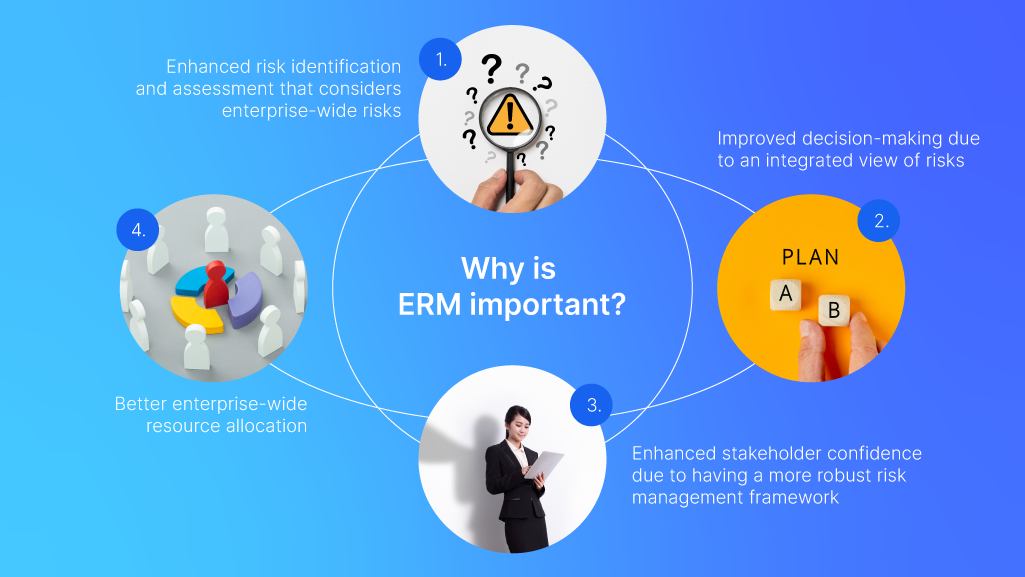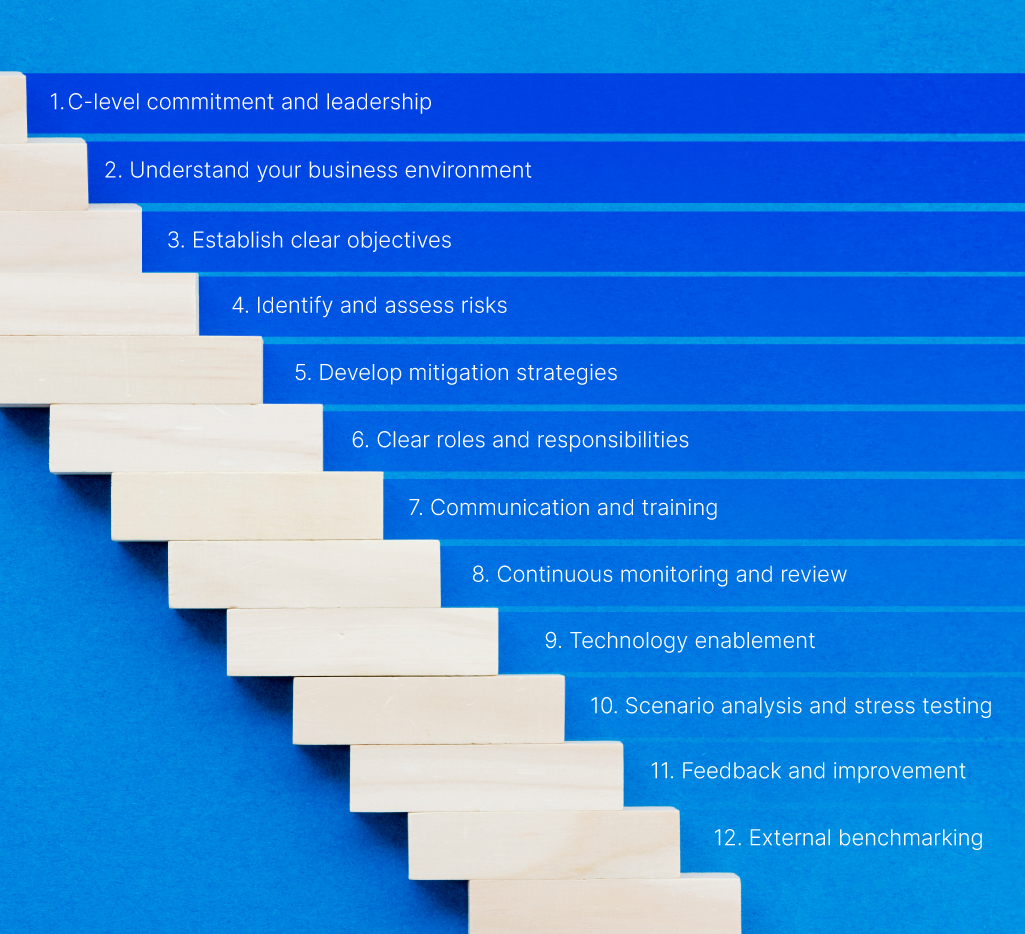Risk management is an important aspect in any business and every business should have a robust risk management plan in order to be successful and be able to navigate turbulent times.
In the earlier parts of our risk management series, we had already explored a few risk management concepts. In Part 1 of our risk management series, we explored what risk management is and what its role is in a business’s success. We followed up with Part 2 by proposing a risk management plan for a successful business.
This article will be the third and last part of this series where we seek to provide insights into what Enterprise Risk Management (ERM) is, why it is important, the difference between ERM and traditional risk management, and best practices on how to integrate ERM strategies in your business planning.
Enterprise Risk Management (ERM): What it is and why it’s important
What is ERM?
Enterprise Risk Management, or ERM, is a comprehensive approach to identifying, assessing, and managing risks across all levels of your organization. It involves integrating risk management practices into your strategic planning and decision-making processes, enabling you to proactively anticipate and mitigate potential threats.
Why is ERM important?
ERM provides a comprehensive approach to risk management. It goes beyond traditional risk management, and takes into account a wide range of potential threats. In today’s dynamic business environment, risks are ever-present.
From operational risks to market risks, strategic risks to external risks like natural disasters, businesses face a multitude of threats on a daily basis. ERM enables you to have a systematic and structured approach to identify and assess these risks. Here are some benefits of adopting ERM in your business:
- Enhanced risk identification and assessment: ERM enables businesses to identify and assess risks more effectively by considering risks at an enterprise-wide level. This can help uncover hidden risks and address potential vulnerabilities.
- Improved decision-making: By taking an integrated view of risks, ERM provides decision-makers with a more comprehensive understanding of the potential impact of their decisions. This can help optimize decision-making processes and improve overall business performance.
- Better resource allocation: ERM allows businesses to allocate resources more effectively by prioritizing risks based on their potential impact and likelihood. This can help ensure resources are allocated to areas with the greatest risk exposure.
- Enhanced stakeholder confidence: By demonstrating a robust ERM framework, businesses can instill confidence in their stakeholders, including customers, investors, and regulators. This can help build trust and enhance the organization’s reputation.
Differences between ERM and traditional risk management
Risk management and enterprise risk management (ERM) are related concepts that both aim to identify, assess, and mitigate risks within an organization, but they differ in scope and approach.
Risk Management
Risk management is a comprehensive process that focuses on identifying, assessing, and mitigating risks that an organization faces in its day-to-day operations. It involves evaluating potential threats and opportunities, developing strategies to minimize the negative impact of risks, and maximizing the potential benefits of opportunities.
Risk management often operates within specific departments or functional areas of a business, such as finance, operations, or IT. It addresses risks that are directly related to a specific project, process, or department, and its primary goal is to protect the interests of that particular area.
Enterprise Risk Management (ERM)
Enterprise risk management, on the other hand, takes a broader and more holistic approach. ERM is a strategic and integrated process that considers risks across the entire organization, recognizing that risks are interconnected and can have cascading effects.
ERM involves aligning risk management strategies with the organization’s overall goals and objectives. It seeks to create a unified framework that enables a comprehensive understanding of risks and their potential impacts on the entire business.
ERM involves top-level executives and the board of directors, as it aims to provide a comprehensive view of risks that could affect the organization’s long-term sustainability and success. It encourages a proactive and strategic approach to risk identification and management, fostering a culture of risk-aware decision-making at all levels of the organization.
Here’s a quick summary of the differences between the two:
| Category | Risk Management | Enterprise Risk Management (ERM) |
| Scope | Focuses on day-to-day operations within specific departments or functional areas like finance, operations, or IT. | Takes a holistic approach, considering risks across the entire organization. |
| Goal | Protects the interests of the specific area it operates in. |
|
| Risk Perspective | Evaluates potential threats and opportunities within its domain. | Recognizes interconnected risks and cascading effects in the organization. |
| Strategy Alignment | Strategies developed to minimize negative impacts and maximize opportunities within the domain. |
|
| Involvement | Typically involves personnel within a specific department or functional area. | Involves top-level executives and the board of directors. |
| Approach to Identification | Addresses risks related to a specific project, process, or department. | Proactive and strategic approach, fostering a risk-aware culture at all organizational levels. |
| Framework and Integration | Addressed within the specific operational areas. | Seeks a comprehensive, cohesive framework integrated into strategic planning and decision-making processes. |
In essence, while risk management addresses risks within specific operational areas, enterprise risk management considers risks across the entire organization and integrates risk considerations into the organization’s strategic planning and decision-making processes. ERM recognizes that risks can arise from various sources and can have interrelated effects on different aspects of the business. As a result, ERM aims to provide a comprehensive and cohesive framework for managing risks in a way that aligns with the organization’s overall mission, values, and objectives.
Best practices for implementing ERM in your business
Implementing enterprise risk management (ERM) practices is a crucial step for business owners looking to safeguard their business and navigate potential challenges. When taking a proactive approach to risk management, business owners can protect their investments, optimize resource allocation, and drive long-term success.
Here are some key steps to help you effectively implement ERM practices in your business:
1. C-level commitment and leadership: ERM begins at the top. Securing commitment from your executive leadership, including the board of directors and senior management, is paramount. Their endorsement and involvement set the tone for a risk-conscious culture throughout the organization.
2. Understand your business environment: Then, start by gaining a deep understanding of your industry, market trends, and competitive landscape. Identify the potential risks that could impact your business, such as financial risks, operational risks, strategic risks, and external risks like natural disasters or regulatory changes. This will form the foundation for your risk management strategy.
3. Establish clear objectives: Clearly define your business objectives and establish your risk appetite. Your risk appetite represents the level of risk you are willing to take to achieve your objectives. It’s important to align your risk management strategy with your overall business strategy and ensure that your risk tolerance is in line with your financial goals.
4. Identify and assess risks: Conduct a comprehensive risk assessment to identify potential risks and evaluate their potential impact on your business. Consider both internal and external factors that could affect your operations. Engage diverse teams to identify risks specific to various departments, operations, and strategic goals. This holistic approach ensures that no risk goes unnoticed.
5. Develop mitigation strategies: Once you have identified the risks, develop strategies to mitigate their impact. This may involve implementing controls, establishing contingency plans, or transferring some risks through insurance or other risk transfer mechanisms. Prioritize the risks based on their likelihood and potential impact, and allocate resources accordingly.
6. Clear roles and responsibilities: Clearly define roles and responsibilities for ERM across the organization. Designate risk owners who are accountable for managing specific risks. This accountability fosters a sense of ownership and ensures that risks are actively managed.
7. Communication and training: Foster a culture of risk awareness through effective communication. Educate employees at all levels about ERM principles, processes, and their roles in risk management. Regular training sessions keep the organization vigilant and aligned.
8. Continuous monitoring and review: Regularly monitor and review your risk management practices to ensure their effectiveness. Establish key performance indicators (KPIs) and metrics to track progress and measure the success of your risk management efforts. Stay updated on industry trends and emerging risks to adapt your strategies accordingly.
9. Technology enablement: Leverage technology to streamline ERM processes. Implement risk management software that allows for efficient risk identification, assessment, and reporting. This technological backbone facilitates data-driven decision-making.
10. Scenario analysis and stress testing: Conduct scenario analysis and stress testing for high-priority risks. Simulating various scenarios helps you understand the potential impacts of different risk events and refine your mitigation strategies.
11. Feedback and improvement: Encourage a feedback loop from employees. Their insights can uncover risks that might not be apparent at higher levels. Use this feedback to continually refine your ERM practices.
12. External benchmarking: Compare your ERM practices with industry benchmarks to assess your risk management maturity and identify areas for growth.
These best practices help set the backbone of a holistic and effective ERM plan for any business. Align your organization with these practices in order to mitigate risks, seize opportunities, and navigate uncertainties.
Safeguard your business with ERM
In a business world characterized by volatility and innovation, ERM is the North Star that guides your business through turbulent waters. When risk management is embedded in every layer of your organization, your business is equipped to avoid pitfalls and take advantage of growth opportunities. We hope that this three-part series on risk management will help your business be more resilient towards risks and enhance your business operations and decision-making.
If you have yet to read the previous articles from this risk management series, do give them a read! Read Part 1 here: Risk management: What it is and its role in business success and Part 2 here: Risk management plan for a successful business.












